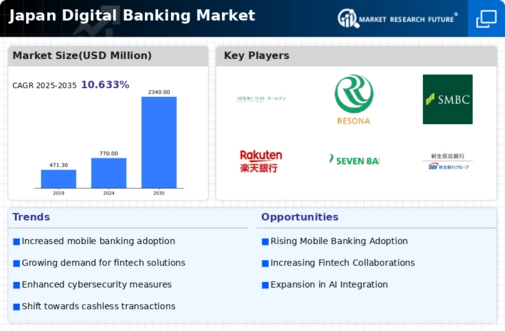Focus on Financial Inclusion
The digital banking market in Japan is increasingly focusing on financial inclusion, aiming to provide banking services to underserved populations. Initiatives aimed at enhancing access to financial services for rural communities and low-income individuals are gaining traction. The government has recognized the importance of financial inclusion, with programs designed to promote digital literacy and access to banking technology. This focus is likely to expand the digital banking market by tapping into previously unbanked segments of the population. As a result, the market could see a growth rate of approximately 10% as more individuals gain access to essential banking services through digital platforms.
Changing Consumer Preferences
Consumer behavior in Japan is shifting towards digital solutions, significantly impacting the digital banking market. A growing number of consumers prefer the convenience of online banking services over traditional banking methods. Surveys indicate that approximately 65% of Japanese consumers now utilize mobile banking applications for their financial transactions. This trend reflects a broader acceptance of digital solutions, particularly among younger demographics. The digital banking market is adapting to these preferences by offering user-friendly interfaces and enhanced functionalities. As consumer expectations evolve, banks are likely to invest more in digital platforms to retain and attract customers, further driving market growth.
Increased Investment in Fintech
Investment in fintech companies is on the rise in Japan, which is positively influencing the digital banking market. Venture capital funding for fintech startups has seen a substantial increase, with investments reaching over $1 billion in 2025. This influx of capital is enabling fintech firms to develop innovative solutions that challenge traditional banking models. The digital banking market is benefiting from this trend as established banks partner with fintechs to enhance their service offerings. Such collaborations are expected to lead to the introduction of new products and services, thereby expanding the market and increasing competition among financial service providers.
Regulatory Support for Digital Banking
The regulatory environment in Japan is increasingly supportive of the digital banking market. The Financial Services Agency (FSA) has implemented policies that encourage innovation while ensuring consumer protection. For instance, the introduction of the Banking Act revisions has facilitated the entry of fintech companies into the market, promoting competition. This regulatory framework is expected to enhance the digital banking market by fostering an ecosystem where traditional banks and fintechs can collaborate. As a result, the market is likely to see a rise in new digital banking solutions that cater to diverse consumer needs, potentially increasing market penetration by 15% over the next few years.
Technological Advancements in Financial Services
The digital banking market in Japan is experiencing a surge due to rapid technological advancements. Innovations such as blockchain, artificial intelligence, and machine learning are transforming traditional banking operations. These technologies enhance customer experience by providing personalized services and improving transaction efficiency. As of 2025, it is estimated that over 70% of banking transactions in Japan are conducted online, indicating a shift towards digital platforms. This trend is likely to continue as financial institutions invest in technology to streamline operations and reduce costs. The digital banking market is thus poised for growth, driven by the need for banks to adapt to changing consumer preferences and technological capabilities.

















Leave a Comment